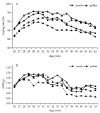Effect of the Pellet and Mash Feed Forms on the Productive Performance, Egg Quality, Nutrient Metabolism, and Intestinal Morphology of Two Laying Hen Breeds
- PMID: 33807718
- PMCID: PMC7998960
- DOI: 10.3390/ani11030701
Effect of the Pellet and Mash Feed Forms on the Productive Performance, Egg Quality, Nutrient Metabolism, and Intestinal Morphology of Two Laying Hen Breeds
Abstract
One of the most important factors that determine feed utilization by chickens is the feed form. Although it is generally believed that pellet diets have a positive effect on chicken growth, there are some studies that have indicated no difference between pellet and mash on chickens performance. This study was conducted to assess the effects of feed form on production performance, egg quality, nutrient metabolism and intestinal morphology in two breed laying hens. Two hundred and sixteen 25-week-old Hy-Line brown (n = 108) and Hy-Line grey (n = 108) hens were selected. Each breed was randomly allocated into two treatments with 6 replications (9 birds in each replication), which were fed mash and pellet diets, respectively. Production performances were recorded daily and egg quality traits were measured every two weeks. At 42 weeks of age, one bird per replication from each experimental group was selected for metabolism determination and intestine morphology observation. Compared with mash diets, pellet diets improved laying rate (p < 0.05), ADFI (average daily feed intake, p < 0.05), egg weight, shell strength, yolk proportion and Haugh unit (p < 0.05) in both breeds and reduced the FCR (feed conversion ratio, p < 0.05) in Hy-Line grey. The apparent digestibility of DM% (dry matter) and CP% (crude protein) were significantly higher (p < 0.05) in both breed laying hens fed pellet than those fed mash. The apparent digestibility of P% (phosphorus) and Ca% (calcium) was higher in Hy-Line grey fed pellet and was higher in Hy-Line brown fed mash. Compared to mash diets, pellet diets increased the VH (villus height), CD (crypt depth) and VCR (ratio of villus height to crypt depth) of the small intestine of Hy-Line grey, and increased the VH and CD of duodenum and ileum of Hy-Line brown. Overall, pellet diets improved production performance and nutrition metabolism through positive changes in the laying rate, feed intake, egg albumen quality and apparent digestibility of laying hens. The current findings provided support for the advantages of feeding pellets during the peak egg laying period for the two popular laying hen strains, Hy-Line brown and Hy-Line grey.
Keywords: feed form; intestinal morphology; laying hen; nutrient metabolism; production performance.
Conflict of interest statement
The authors declare no conflict of interest. The funders had no role in the design of the study; in the collection, analyses, or interpretation of data; in the writing of the manuscript, or in the decision to publish the results.
Figures
References
-
- Zaefarian F., Abdollahi M.R., Ravindran V. Particle size and feed form in broiler diets: Impact on gastrointestinal tract development and gut health. World Poult. Sci. J. 2016;72:277–290. doi: 10.1017/S0043933916000222. - DOI
-
- Abdollahi M.R., Ravindran V., Svihus B. Influence of feed form on growth performance, ileal nutrient digestibility, and energy utilisation in broiler starters fed a sorghum-based diet. Livest. Sci. 2014;65:80–86. doi: 10.1016/j.livsci.2014.04.002. - DOI
-
- Abadi M.H.M.G., Moravej H., Shivazad M., Torshizi M.A.K., Kim W.K. Effects of feed form and particle size, and pellet binder on performance, digestive tract parameters, intestinal morphology, and cecal microflora populations in broilers. Poult. Sci. 2019;98:1432–1440. doi: 10.3382/ps/pey488. - DOI - PubMed
Grants and funding
LinkOut - more resources
Full Text Sources
Other Literature Sources
Miscellaneous


